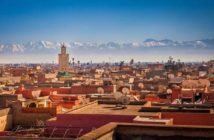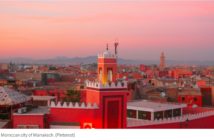
The usually sleepy seaside town of Assilah comes to life during a month-long cultural festival, as international artists transform the streets into an outdoor art gallery. (Reuters)
By REUTERS
The Moroccan town of Assilah welcomed international artists to its shores as an annual month-long cultural festival kicked off in July.
The event brings the seaside resort to life each year and has turned around the town’s fortunes. Workers whitewash the walls of the streets in the town located on the northwest tip of Morocco, awaiting the brightly colored creations of artists from around the world that will turn the sleepy town into an outdoor art gallery.
Moroccan artist Mohammed Qannibou says painting a mural as passers-by look on brings a new dimension to the process of his creations.
“For me working on the walls of Assilah provides an opportunity to experience something unique. It’s not like being in a studio where you work on canvas directly. Here you are in the streets and in contact with people. You are facing a wall, a huge wall and that brings a human dimension and also you are working in a different medium,” said Mohammed.
Syrian calligrapher Khaled al Saai, who also featured in the festival last year, says he aims to connect his viewers with the art of calligraphy.
“I am trying with my work to draw attention to calligraphy and to the possibilities of the art of calligraphy. The other thing is that, through the story of Noah’s Ark, I want to put across the message that we are all humans who share worries and share happiness, and we all try to strive towards what is better in this life,” he said, as he worked on a mural of the ocean formed from a layering of Arabic words.
The festival, or ‘Moussem’, has been running since 1978, and welcomes artists from across the Arab world and beyond. This year it has extended its reach featuring the works of artists from Japan and Hungary.
Bahraini artist Abdulla Yousif started his art career as a stage designer, who was drawn into the world of painting when making backdrops for the theatre.
“I’ve learned my profession through working as a stage set designer. You have to paint landscapes that are suitable for each act in a play. I have thirty years’ experience in this field of set design and painting,” he said.
As well as the established muralists the festival brings together leading engravers to its workshop to teach a younger generation about print making.
According to Mouna Sadl, a student artist, just rubbing shoulders with the likes of her teacher French engraver Hector Saunier, is a great boon because of the breadth of his experience.
“The most important thing in this workshop is to gain experience directly from someone like Hector — from an artist like him — because he worked on developing one of the most important forms of art in the 20th century, which is the art of engraving, and he worked in one of the most important studios in this field, in which other great names worked — the likes of Picasso even and others,” said Sadl.
The cultural festival was initially established 34 years ago to rehabilitate what was once a decaying town. Since then, the event has led to an influx of both artists and tourists, turning the town’s fortunes around, with a huge body of art work collected.
The visiting artists have set up their studios in Assilah’s historic Raissouni Palace – a former governor’s home, which has been extensively renovated and now functions as a cultural center.
Among noted attendants to this year’s first session of the festival was Spai’s former Prime Minister Jose Luis Rodriguez Zapatero. The festival is said to focus on the economic problems besetting countries to the north of the Mediterranean and the unrest rocking those to the south.
Founder of the festival and mayor of Assilah, Mohamed Benaissa is credited with the transformation of the town.
“When we began in 1987 employing culture and art to promote development, children participated in painting on the walls, and some of them now are big artists. Assilah has become a meeting place for artists from around the world. We now have around a thousand artistic works from artists from around the world,” said Benaissa who says he encourages participants at the painting workshops to donate two art works each to the foundation.
Like last year, this year’s murals will stay in place for the duration of the festival – before the walls are whitewashed again, ready for next year’s artists to make their mark in Assilah.






